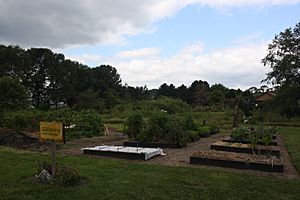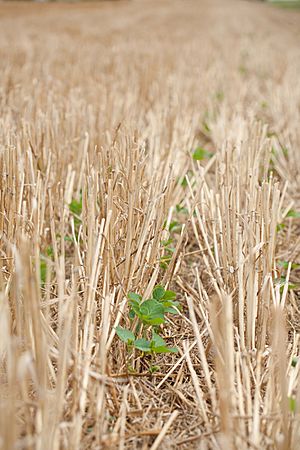Regenerative farming facts for kids
Regenerative agriculture is a special way of farming that helps heal and improve our food and farming systems. It focuses on making the top layer of soil healthy again, increasing the variety of plants and animals (called biodiversity), and improving how water moves through the land. This approach also helps nature's services, like clean air and water, and stores carbon from the air in the soil. It makes farms stronger against climate change and keeps the soil healthy and full of life.
Regenerative agriculture isn't just one specific farming method. Instead, it's a mix of many different sustainable agriculture techniques. Farmers try to reuse as much waste from the farm as possible. They also add rich, decayed plant and animal material (called compost) from both on and off the farm.
When soil becomes healthier, farmers might need fewer extra things like fertilizers. Crops can grow better because the soil is stronger against bad weather. Healthy soil also has fewer pests and diseases that can harm plants.
Regenerative agriculture helps fight climate change by removing carbon dioxide from the air and storing it in the soil. This process is called carbon sequestration. As people learn more about how to store carbon in the soil, more individuals and groups are working to use these methods to help the planet.

Contents
How Regenerative Agriculture Started
Early Ideas and Beginnings
The ideas behind regenerative agriculture come from many old farming and nature-friendly practices. A big part of it is disturbing the soil as little as possible and using compost. Maynard Murray had similar ideas, using minerals from the sea to improve soil. His work led to new ways of farming without tilling, like "slash and mulch" in tropical places. Sheet mulching, which covers weeds and adds nutrients to the soil, is another regenerative practice.

In the early 1980s, an organization called the Rodale Institute started using the phrase 'regenerative agriculture'. They even created a group called the Regenerative Agriculture Association. This group began publishing books about regenerative agriculture in the late 1980s.
Robert Rodale, who was part of the Rodale Institute, once said:
By marching forward under the banner of sustainability we are, in effect, continuing to hamper ourselves by not accepting a challenging enough goal. I am not against the word sustainable, rather I favor regenerative agriculture.
—Robert Rodale
The Rodale Institute stopped using the term for a while. But in 2014, they released an important report. It was called "Regenerative Organic Agriculture and Climate Change." The report suggested that we could remove more than 100% of the carbon dioxide currently released into the air each year. This could happen if we switched to simple and cheap organic farming methods, which they called 'regenerative organic agriculture.' The report described farming methods like changing crops each season (called crop rotation), adding compost, and tilling the soil less. These are similar to traditional organic farming.
In 2002, Storm Cunningham wrote about what he called "restorative agriculture." He described it as a way to rebuild the amount and quality of topsoil. It also helps bring back local biodiversity, especially helpful insects that pollinate plants.
Recent Growth (Since 2010)
Many Indigenous cultures have known about regenerative farming techniques for centuries. While the practices are old, the term "regenerative agriculture" has only become popular more recently. Since the early 2010s, it has appeared more and more in scientific studies about the environment, plants, and nature. As the term became more widely used, many books were published, and several groups started to promote these farming methods.
In 2013, Allan Savory gave a famous TED talk about fighting and reversing climate change. He also started The Savory Institute, which teaches ranchers how to manage their land in a way that helps nature.
A non-profit group called Kiss the Ground, started in 2013, helped make the term known to more people. This group now works on media, farmland, education, and policy programs. They want to raise awareness about soil health and help farmers switch to regenerative methods. A film called Kiss the Ground, narrated by Woody Harrelson, was released in 2020.
Not all regenerative farming systems use grazing animals like cows. In 2017, Reginaldo Haslett Marroquin wrote about how his early life in Guatemala led him to create regenerative poultry farming systems. These systems combine raising chickens with growing trees (called agroforestry). These methods are now used in the United States and other places.
Many large companies have also started regenerative agriculture projects. In 2019, General Mills announced plans to encourage regenerative farming practices among the farmers who supply their ingredients. In 2021, PepsiCo announced they would work with farmers to use regenerative agriculture on about 7 million acres by 2030. Unilever, VF Corporation (which owns brands like The North Face), and Nestle also announced big plans to invest in regenerative agriculture.
In February 2021, the idea of regenerative agriculture gained more attention when Tom Vilsack, the United States Secretary of Agriculture, mentioned it. The Biden administration wants to use money to encourage farmers to adopt sustainable practices.
A report published just before the 2022 United Nations Climate Change Conference said that regenerative agriculture is already used on 15% of all farmland. However, the report, sponsored by large farming companies, said that this change is "far too slow." It needs to happen three times faster by 2030 to prevent global temperatures from rising too much.
Main Ideas of Regenerative Agriculture
Many people and groups have tried to explain the main ideas of regenerative agriculture. Researchers at Wageningen University looked at many studies on the topic. They found that people often used different ideas to guide their regenerative agriculture efforts. However, four main ideas were mentioned most often:
- Making soil healthier and better.
- Using resources in the best way possible.
- Helping to reduce climate change.
- Improving the quality and availability of water.
Important Definitions of Principles
The organization The Carbon Underground created a set of principles that many non-profits and companies, like Ben & Jerry's and the Rodale Institute, have agreed to. Their principles include:
- Building soil health and fertility.
- Increasing how well water soaks into the ground and stays there.
- Increasing biodiversity and the health of natural systems.
- Reducing carbon emissions and current carbon dioxide levels in the air.
Another group, Terra Genesis International, has four principles:
- "Always improve the whole farming ecosystem (soil, water, and biodiversity)."
- "Design specific plans for each farm and make decisions that fit its unique nature."
- "Make sure relationships among everyone involved are fair and helpful to each other."
- "Help individuals, farms, and communities keep growing and developing their full potential."
Instead of focusing only on how food is grown, a human ecologist named Philip Loring suggests looking at the entire food system. He believes that a combination of flexibility and diversity in our food systems helps regenerative practices. Loring says that food systems can fit into four patterns:
- Regenerative (high diversity, high flexibility): Ecosystems can reuse and renew energy, like in many Indigenous food systems.
- Degenerative (high diversity, low flexibility): People focus on specific resources and only switch when those run out, like fishing too much of one type of fish.
- Coerced (low diversity, low flexibility): People support valuable resources even if it harms the surrounding environment.
- Impoverished (low diversity, high flexibility): People are willing to be flexible, but because they live in damaged environments, they can't let nature and resources recover.
The organization Climate Farmers says that defining regenerative agriculture by its results is very important. This is because the land's shape, climate, soil type, and water availability all affect farming. So, regenerative practices only work well if they consider the unique conditions of each farm.
Regenerative Farming Methods
Here are some practices and ideas used in regenerative farming:
- Alternative food networks: These are ways for farmers and consumers to connect more directly, often locally.
- Aquaculture: Farming aquatic animals or plants.
- Ecological aquaculture: Farming in water in a way that helps nature.
- Regenerative ocean farming: Growing food in the ocean that also helps the marine environment.
- Agroecology: Designing farming systems that work with nature.
- Agroforestry: Combining trees and shrubs with crops or livestock on the same land.
- Biochar: A special charcoal added to soil to improve it.
- Biostimulants: Substances that help plants grow better.
- Pollinator borders: Planting special areas around fields for pollinators and other helpful insects.
- Compost: Decayed organic material used to enrich soil. Also, compost tea and animal manures.
- Conservation farming: Farming methods that protect the soil. This includes no-till farming (not plowing the soil) and minimum tillage (plowing very little).
- Cover crops: Plants grown to protect and enrich the soil, often between main crops.
- Home gardens: Growing food at home to help with food security and nutrition.
- Regrowing vegetables: Reusing parts of vegetables to grow new ones, for recycling and sustainable living.
- Keyline subsoiling: A way to plow the land to help water soak in evenly.
- Livestock management: Carefully managing grazing animals like cows to improve the land. This includes holistically managed grazing.
- Grass-fed cattle: Raising cows that eat only grass.
- Natural Sequence Farming: A method that mimics natural water flow to heal damaged land.
- Organic annual cropping: Growing crops organically each year, often with crop rotation.
- Perennial crops: Plants that live for more than two years, so they don't need to be replanted every season.
- Ponding banks: Small earth banks that help prevent soil erosion and manage water.
- Permaculture design: Designing sustainable human settlements and agricultural systems.
- Polyculture: Growing many different crops together in the same area.
- Silvopasture: Combining trees, forage, and grazing animals on the same land.
- Soil food web: The community of living things in the soil that help it stay healthy.
Environmental Benefits
Storing Carbon in the Soil
Traditional farming methods, like plowing and tilling, release carbon dioxide (CO2) from the soil. This happens because they expose organic matter to the air, causing it to break down. Scientists believe that about one-third of all the CO2 humans have added to the atmosphere since the Industrial Revolution came from damaged soil. Also, 30–75% of the world's soil organic matter has been lost since farming with tillage began.
Regenerative agriculture practices can help reverse this trend. Methods like no-till farming, rotational grazing, mixed crop rotation, cover cropping, and adding compost can put carbon back into the soil. No-till farming, for example, presses crop leftovers into the soil when new seeds are planted. Some studies suggest that using no-till methods could triple the amount of carbon in the soil in less than 15 years. Globally, if all farmlands switched to no-till systems, they could store about one-fourth to one-third of human-caused CO2 emissions each year.
Regenerative grazing, especially a method called adaptive multipaddock (AMP) grazing, has been shown to reduce soil damage compared to letting animals graze freely all the time. This can help reduce carbon emissions from the soil. Crop rotation and keeping permanent cover crops also help reduce soil erosion. When combined with AMP grazing, these methods can lead to the soil actually taking in carbon from the air. One study suggests that if all livestock farming in North America switched to AMP grazing and conservation cropping, farmlands could become a "carbon sink," storing about 1.2 billion tons of carbon each year.
Research by the Rodale Institute suggests that if the whole world switched to regenerative agriculture, it could absorb more than 100% of the CO2 currently released by people.
Nutrient Cycling
The organic matter in soil is where plants get many important nutrients like nitrogen, phosphorus, and zinc. Traditional farming methods that involve tilling quickly wear away and damage soil organic matter. This removes nutrients from the soil and makes it less productive. Tilling, along with adding artificial fertilizers, also harms the tiny living things (microbes) in the soil. These microbes are important for creating natural nutrients.
Practices that bring back organic matter can increase the total amount of nutrients in the soil. For example, managing grazing animals in a regenerative way, combined with mixed crops, has been shown to improve how nutrients move through the soil. This happens by encouraging animals to eat and break down leftover crop plants. It also helps nitrogen-fixing plants grow, which add nitrogen to the soil. Regenerative crop management, like using crop rotation to keep the ground covered, can also make the soil more fertile and increase nutrient levels, especially if nitrogen-fixing crops are part of the rotation.
Boosting Biodiversity
Traditional farming often simplifies natural systems by growing only one type of crop (monocultures) and destroying the variety of microbes in the soil with chemicals. In natural environments, biodiversity helps keep the ecosystem balanced. But in traditional farming, this natural balance is lost, requiring more human input.
In contrast, regenerative agriculture practices help increase the overall variety of species. These practices include growing many different crops together (polycultures), rotating crops, using cover crops, managing soil organically, and using low- or no-tillage methods. These methods also help reduce the number of pests. Practices that use natural inputs instead of artificial ones help bring back the variety of life below ground by improving how soil microbes work. A study of organic and traditional farms in Europe found that organic farms generally had more types of species, especially those harmed by traditional farming.
Well-managed grazing can also improve biodiversity. When soil stores more organic carbon, it also supports a greater variety of soil microbes. For example, using AMP grazing in North American prairies has been linked to more forage growth and the return of plant species that were previously destroyed by continuous grazing. Studies in dry regions where regenerative grazing has been practiced for a long time have shown a return of biodiversity, grass species, and pollinator species. Also, growing different types of crops helps the farm stay productive even if soil fertility is lower. More plant diversity leads to increases in many factors that help soil fertility, such as soil nitrogen, potassium, calcium, magnesium, and carbon.
See also
 In Spanish: Agricultura regenerativa para niños
In Spanish: Agricultura regenerativa para niños
- Agroecology
- Agroforestry
- Biointensive agriculture
- Carbon farming
- Permaculture
- Regenerative design
|




